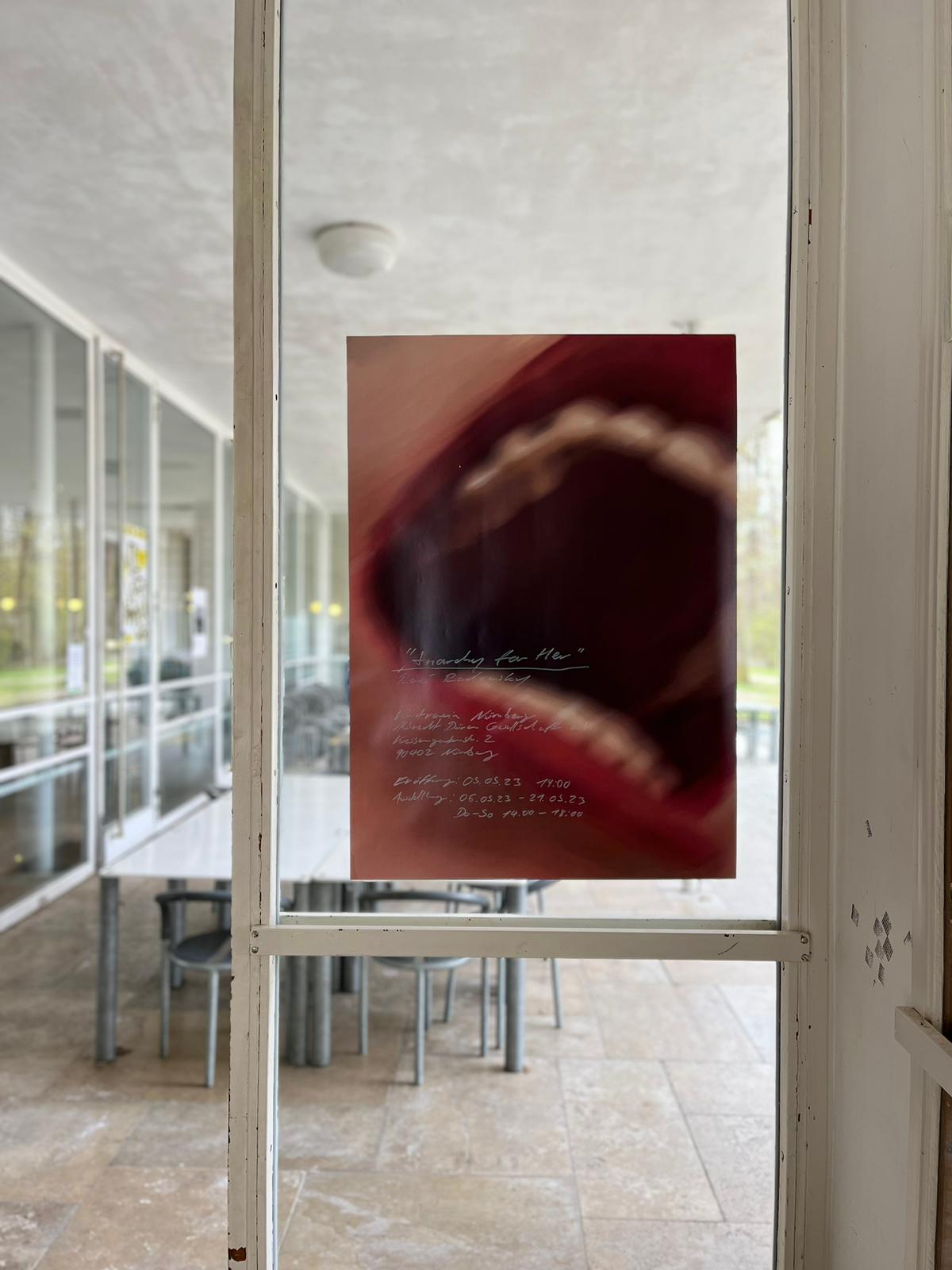Anarchy for Her
Eröffnung / Opening: 05.05.2023, 19:00 Uhr
In seiner Einzelausstellung „Anarchy for Her“ bringt René Radomsky drei bildkünstlerische Ausdrucksformen in einen Zusammenhang, die für gewöhnlich nicht gemeinsam Gegenstand kritischer Betrachtung in einer Kunstinstitution sind: Malerei auf Leinwand – aufgetragen sowohl mit Pinsel und Ölfarbe als auch mithilfe des für Tätowierungen verwendeten Stencil Papiers –, Zeichnungen, die in Vitrinen zu sehen sind, sowie Tätowierungen von diesen Zeichnungen.
Jenseits der, vor dem Hintergrund seiner Praxis als bildender Künstler und Tätowierer, grundlegenden Frage nach den definitorischen Grenzen zwischen Kunst und Handwerk im allgemeinen, führt diese besondere Kombination figurativer Bildproduktion zu zahlreichen weiteren Überlegungen, die auch das Selbstverständnis einer Einrichtung der Gegenwartskunst berühren: Welchen Stellenwert nimmt Malerei, nach wie vor die Königsdisziplin des Kunstbetriebs, zumindest des Kunstmarktes, in einer solchen Konstellation ein? Wie ist es um das Verhältnis zwischen subkulturell und hochkulturell codierter Bildsprache bestellt? Wird Tätowieren dann zur Kunst, wenn der Tätowierer René Radomsky ausschließlich Motive des bildenden Künstlers René Radomsky im Angebot hat? Oder wird ein solches Motiv erst zu einem „echten“ Radomsky, wenn es als eigenständige Zeichnung in das Werkverzeichnis aufgenommen wurde? Welche Parallelen lassen sich, historisch gesehen, zwischen der Geschichte des Tätowierens und der Malereigeschichte erkennen? Warum ist die Tätowierung einer Zeichnung Radomskys günstiger als die Zeichnung selbst? Wird Tätowieren im kunstbetrieblichen Rahmen per definitionem zur Performance, zum Readymade, zur Intervention? Begegnen sich tätowiertes und gemaltes Bild, Haut und Leinwand auf Augenhöhe? Welche Rolle nimmt die Zeichnung als eigentliches Gravitationszentrum des Ganzen ein? Und überhaupt: Was ist wo und wann Kunst?
„Wir alle stehen hier so komisch rum. Es gibt Drinks und Zigaretten, den Geruch von sonnengewärmtem Asphalt und ein bisschen Erde unter den Fingernägeln. Letztere nehme ich mit nach Hause, löse sie mit einer Messerspitze vom Nagelbett, fülle sie in eine kleine Plastiktüte und schreibe “Mutter” drauf. Dann gehe ich wieder vor die Türe und beende mein Leben, indem ich wie alle anderen Steuern zahle, Urlaub mache, Kinder zeuge und mir Auto & Eigenheim gönne. Ich kann nicht glauben, dass es immer wieder funktioniert.“ (René Radomsky)
english version
In his solo exhibition “Anarchy for Her,” René Radomsky brings together three forms of visual expression that are not usually the subject of critical consideration in an art institution: Painting on canvas – applied both with brush and oil paint and with the help of the stencil paper used for tattoos -, drawings on display in showcases, and tattoos of these drawings.
Beyond the fundamental question, against the background of his practice as a visual artist and tattoo artist, of the definitional boundaries between art and craft in general, this particular combination of figurative image production leads to numerous other considerations that also touch on the self-image of an institution of contemporary art: What is the status of painting, still the supreme discipline of the art establishment, at least of the art market, in such a constellation? What is the relationship between subculturally and highly culturally coded visual language? Does tattooing become art when the tattoo artist René Radomsky exclusively offers motifs by the visual artist René Radomsky? Or does such a motif only become a “real” Radomsky when it is included in the catalog raisonné as an independent drawing? What parallels can be seen, historically, between the history of tattooing and the history of painting? Why is tattooing a drawing by Radomsky more favorable than the drawing itself? Does tattooing in the art establishment framework by definition become a performance, a readymade, an intervention? Do tattooed and painted image, skin and canvas meet at eye level? What role does the drawing take as the actual center of gravity of the whole? And in general: What is art where and when?
“We’re all standing around here so funny. There are drinks and cigarettes, the smell of sun-warmed asphalt and a bit of soil under the fingernails. I take the latter home, loosen it from the nail bed with the tip of a knife, put it in a small plastic bag and write “Mother” on it. Then I walk back out the door and finish my life paying taxes like everyone else, taking vacations, fathering children, and treating myself to a car & home of my own. I can’t believe it keeps working.” (René Radomsky)


Installationsansicht / Installation view: „Anarchy for Her“, René Radomsky, Kunstverein Nürnberg, 2023
Photo: © René Radomsky

Installationsansicht / Installation view: „Anarchy for Her“, René Radomsky, Kunstverein Nürnberg, 2023
Photo: © René Radomsky

Installationsansicht / Installation view: „Anarchy for Her“, René Radomsky, Kunstverein Nürnberg, 2023
Photo: © René Radomsky

Installationsansicht / Installation view: „Anarchy for Her“, René Radomsky, Kunstverein Nürnberg, 2023
Photo: © René Radomsky

Installationsansicht / Installation view: „Anarchy for Her“, René Radomsky, Kunstverein Nürnberg, 2023
Photo: © René Radomsky

Installationsansicht / Installation view: „Anarchy for Her“, René Radomsky, Kunstverein Nürnberg, 2023
Photo: © René Radomsky

Installationsansicht / Installation view: „Anarchy for Her“, René Radomsky, Kunstverein Nürnberg, 2023
Photo: © René Radomsky

Installationsansicht / Installation view: „Anarchy for Her“, René Radomsky, Kunstverein Nürnberg, 2023
Photo: © René Radomsky
